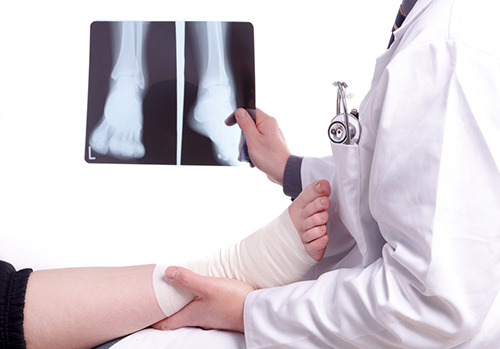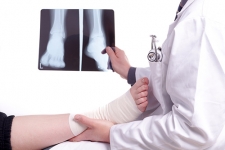
Tripping on a curb, slipping in the shower, or falling down the stairs… accidents happen. Sprains, strains, and breaks are common results of these accidents. Additionally, each of these injuries often have similar symptoms, so it might be hard to determine the severity of your injury on your own. Let’s take a look at the difference between sprains, strains, and breaks…
What is a Sprain?
A sprain occurs when a ligament, which connects bones at the joint, is stretched or torn. In mild cases, the joint will remain stable. If the ligament has a slight tear and has some instability then it will be considered a moderate sprain. And in the most severe cases, the ligament is completely torn and is no longer attached to the bone, which will make it impossible for the joint to function properly.
There are many ways to get a sprain, but it’s likely due to making an unnatural movement with the joint. The most common body parts to sprain are ankles, wrists, and elbows but any joint can be sprained.
When injured, the symptoms will depend on the severity of the sprain. Here are some signs of a sprain:
- Pain in the soft tissue over the bone
- Limited mobility
- Swelling and bruising
- You can put weight on it (but may be painful)
- “Popping” sound at the time of injury
If you have a mild or moderate sprain, you can likely treat it at home using the RICE method (explained below). However, if the sprain doesn’t heal with at-home care, a visit to the doctor may be in order.
What is a Strain?
A stretch or tear in a tendon or muscle causes a strain. These tendons are fibrous tissues that attach the muscle to the bone. A strain may seem similar to a sprain because they both involve tissue surrounding the joint. However, the cause is likely due to overuse rather than trauma. Common strains are found in the lower back and hamstrings, especially in athletes.
Once again, the symptoms will depend on the severity of the injury, but the most common signs of a strain are:
- Pain
- Swelling
- Difficulty moving the muscle
- Muscle spasms
Initial treatment for strains is the same as a sprain – the RICE method (explained below). But, if the injury is severe, it should be looked at and diagnosed by a doctor. Some strains may need physical therapy or surgery to heal.
What is a Break?
A break, or fracture, is when a force causes the bone to break. There are different types of fractures depending on if you have just a crack versus a complete break of the bone. Breaks can happen under several circumstances, but most commonly occur when catching yourself while falling, sports injuries, and car accidents.
As mentioned, breaks can vary in severity, which means the symptoms may change case by case. However, these are the most common signs of a break:
- Pain on top of the bone
- Pain becomes worse with pressure
- Swelling and bruising
- Deformation of the area
- Mobility restricted
It is critical to go to the doctor if you think you have broken a bone. The doctor can take an x-ray to determine the injury and severity of it. Breaks typically require a splint or cast and immobilization. In the most serious cases, physical therapy and surgery may be needed to recover.
How to Use the RICE Method
For mild strains and sprains that don’t need medical attention, use the RICE method. This method will help relieve some of the discomfort, swelling, and bruising.
- Rest: Rest the injured area by moving it as little as possible. After a few days, try gently stretching or exercising to help increase the blood flow, which will help it continue to heal.
- Ice: Apply an ice pack wrapped in a towel to the injured area. Apply for 15 minutes and repeat 3-4 times a day to reduce inflammation.
- Compression: Wrap the injured area with an elastic bandage to reduce swelling and keep it stable. Don’t wrap too tightly.
- Elevation: Raise the injured area above the level of your heart. Use a pillow to prop the area up while laying down. This will reduce swelling and promote faster healing.
Closing Thoughts
If you aren’t sure whether you have a sprain, strain, or break, make an appointment at Prairie Orthopaedic & Plastic Surgery, PC in Lincoln, NE. We can give you a definitive diagnosis and treatment plan for your injury. For excellent orthopaedic care, call 402-489-4700 today.
Resource: Broken Bone or Sprain, HCA Midwest Health https://hcamidwest.com/service/broken-bone-or-sprain

